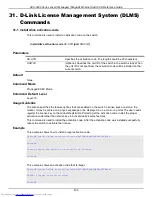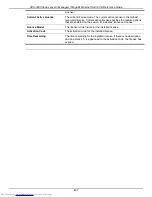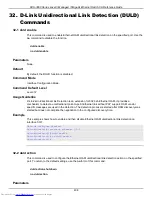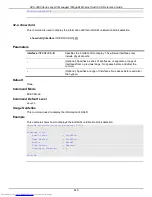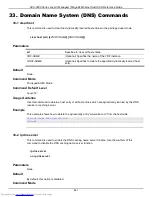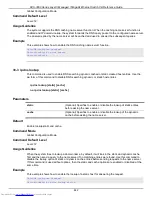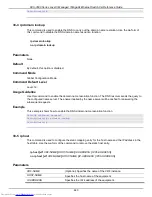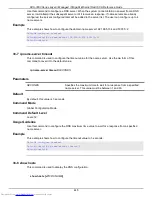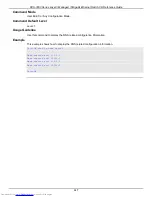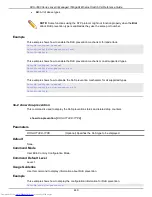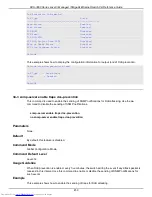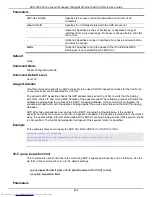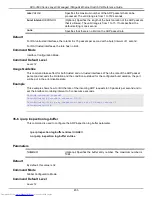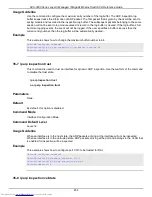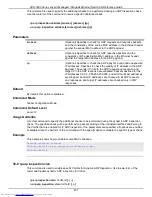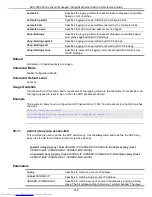
DXS-3600 Series Layer 3 Managed 10Gigabit Ethernet Switch CLI Reference Guide
448
34.
DoS Prevention Commands
34-1 dos-prevention
This command is used to enable and configure the DoS prevention mechanism. Use the
no
form of this
command to reset DoS prevention to the default setting.
dos-prevention DOS-ATTACK-TYPE
no dos-prevention DOS-ATTACK-TYPE
Parameters
DOS-ATTACK-TYPE
Specifies the string that identifies the DoS type to be configured.
Default
By default all supported DoS types are disabled.
Command Mode
Global Configuration Mode.
Command Default Level
Level: 12.
Usage Guideline
This command is used to enable and configure the DoS prevention mechanism for a specific DoS attack
type or for all supported types. The DoS prevention mechanisms (matching and taking action) are
hardware-based features.
When DoS prevention is enabled, the switch will log the event if any attack packet was received.
The command
no dos-prevention
with the
all
keyword is used to disable the DoS prevention mechanism
for all supported types. All the related settings will be reverted back to the default for the specified attack
types.
The following well-known DoS types which can be detected by most switches:
•
Blat:
This type of attack will send packets with TCP/UDP source port equals to destination port to
the target device. It may cause the target device respond to itself.
•
Land:
A LAND attack involves with IP packets where the source and destination address are set
to address of the target device. It may cause the target device reply to itself continuously.
•
TCP-NULL-scan:
Port scanning by using specific packets, which contain a sequence number of
0 and no flags.
•
TCP-SYN-fin:
Port scanning by using specific packets, which contain SYN and FIN flags.
•
TCP-SYN-SRCport-less-1024:
Port scanning by using specific packets, which contain source
port 0-1023 and SYN flag.
•
TCP-xmas-scan
: Port scanning by using specific packets, which contain a sequence number of 0
and the Urgent (URG), Push (PSH), and FIN flags.
•
Ping-death:
A ping of death is a type of attack on a computer that involves sending a malformed
or otherwise malicious ping to a computer. A ping is normally 64 bytes in size; many computers
cannot handle a ping larger than the maximum IP packet size, which is 65,535 bytes. Sending a
ping of this size can crash the target computer. Traditionally, this bug has been relatively easy to
exploit. Generally, sending a 65536 byte ping packet is illegal according to networking protocol,
but a packet of such a size can be sent if it is fragmented; when the target computer reassembles
the packet, a buffer overflow can occur, which often cause a system crash.
•
TCP-tiny-frag:
Tiny TCP Fragment attacker uses the IP fragmentation to create extremely small
fragments and force the TCP header information into a separate packet fragment to pass through
the check function of the router and issue an attack.
Summary of Contents for DXS-3600 Series
Page 1: ......
Page 423: ...DXS 3600 Series Layer 3 Managed 10Gigabit Ethernet Switch CLI Reference Guide 418 ...
Page 548: ...DXS 3600 Series Layer 3 Managed 10Gigabit Ethernet Switch CLI Reference Guide 543 ...
Page 673: ...DXS 3600 Series Layer 3 Managed 10Gigabit Ethernet Switch CLI Reference Guide 668 ...
Page 712: ...DXS 3600 Series Layer 3 Managed 10Gigabit Ethernet Switch CLI Reference Guide 707 Switch ...
Page 845: ...DXS 3600 Series Layer 3 Managed 10Gigabit Ethernet Switch CLI Reference Guide 840 ...
Page 884: ...DXS 3600 Series Layer 3 Managed 10Gigabit Ethernet Switch CLI Reference Guide 879 ...
Page 1152: ...DXS 3600 Series Layer 3 Managed 10Gigabit Ethernet Switch CLI Reference Guide 1147 ...


